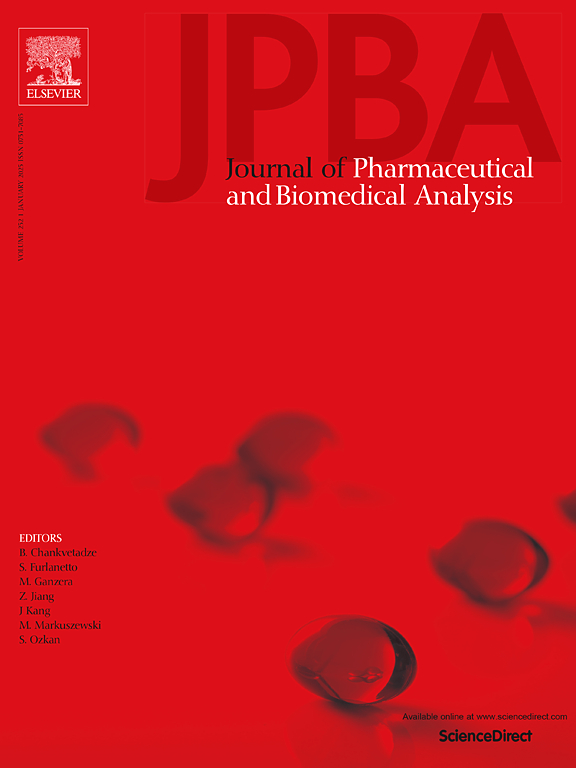建立一种简便的hplc -MS/MS法测定MRX-8在大鼠药动学研究中的含量
IF 3.1
3区 医学
Q2 CHEMISTRY, ANALYTICAL
Journal of pharmaceutical and biomedical analysis
Pub Date : 2025-05-04
DOI:10.1016/j.jpba.2025.116943
引用次数: 0
摘要
广泛耐药革兰氏阴性感染的流行率不断上升,需要更安全的多粘菌素类似物,因为传统的多粘菌素受到肾毒性和成分异质性的限制。MRX-8是新一代多粘菌素B1衍生物,旨在降低毒性,同时保持有效的抗菌活性(MIC90 <1 mg/L),具有改善的药代动力学/药效学(PK/PD)靶标。为了克服临床前血液采样量的挑战,我们开发了一种LC-MS/MS方法来定量干血斑(DBS)中的MRX-8。用Whatman 903®卡采集的DBS样本(40 μL血液),用甲酸-水-乙腈(6:64:30,v/v/v)提取,用AB Sciex QTRAP 5500/Shimadzu LC-30A系统进行分析,MRM转换为617.5→155.1 (MRX-8)和402.3→101.2(多粘菌素B1内标)。方法具有良好的线性(0.0200 ~ 10.0 mg/L)、精密度(3.6 ~ 14.1 %)、准确度(87.4 ~ 107.8 %)、回收率(90.1 ~ 102.2 %)和基质效应(108.1 ~ 125.4 %)。在室温(3天)、冷藏(2-8°C, 7天)和冷冻(-20°C/-70°C, 25天)条件下确认DBS的稳定性。血浆-血分布系数(0.59)与血浆药代动力学相关(R²= 0.976)。与传统的血浆取样相比,这种DBS方法减少了血容量,并显著减少了动物负担。这种经过验证的微采样方法为MRX-8的临床前PK评估提供了道德和高效的解决方案,加速了其作为抗耐药病原体关键抗菌药物的发展。本文章由计算机程序翻译,如有差异,请以英文原文为准。
Establish a simple LC-MS/MS method for the determination of MRX-8 by employing dried blood spots in rat pharmacokinetic study
The rising prevalence of extensively drug-resistant gram-negative infections necessitates safer polymyxin analogs, as conventional polymyxins are limited by nephrotoxicity and compositional heterogeneity. MRX-8, a next-generation polymyxin B1 derivative engineered to reduce toxicity while maintaining potent antibacterial activity (MIC90 <1 mg/L), demonstrates improved pharmacokinetic/pharmacodynamic (PK/PD) targets. To overcome challenges in preclinical blood sampling volume, we developed a LC-MS/MS method to quantify MRX-8 in dried blood spots (DBS). DBS samples (40 μL blood) collected on Whatman 903® cards were extracted with formic acid-water-acetonitrile (6:64:30, v/v/v) and analyzed using an AB Sciex QTRAP 5500/Shimadzu LC-30A system with MRM transitions at 617.5→155.1 (MRX-8) and 402.3→101.2 (polymyxin B1 internal standard). The method demonstrated linearity (0.0200–10.0 mg/L), precision (3.6–14.1 %), accuracy (87.4–107.8 %), recovery (90.1–102.2 %), and matrix effects (108.1–125.4 %). DBS stability was confirmed under room temperature (3 days), refrigerated (2–8 °C, 7 days), and frozen (-20 °C/-70 °C, 25 days) conditions. Adjusted DBS concentrations incorporating a plasma-blood distribution coefficient (0.59) correlated with plasma pharmacokinetics (R² = 0.976). Compared to conventional plasma sampling, this DBS approach reduces blood volumes and significantly minimizes animal burden. This validated microsampling method provides an ethical and efficient solution for preclinical PK evaluation of MRX-8, accelerating its development as a critical antibacterial therapy against drug-resistant pathogens.
求助全文
通过发布文献求助,成功后即可免费获取论文全文。
去求助
来源期刊
CiteScore
6.70
自引率
5.90%
发文量
588
审稿时长
37 days
期刊介绍:
This journal is an international medium directed towards the needs of academic, clinical, government and industrial analysis by publishing original research reports and critical reviews on pharmaceutical and biomedical analysis. It covers the interdisciplinary aspects of analysis in the pharmaceutical, biomedical and clinical sciences, including developments in analytical methodology, instrumentation, computation and interpretation. Submissions on novel applications focusing on drug purity and stability studies, pharmacokinetics, therapeutic monitoring, metabolic profiling; drug-related aspects of analytical biochemistry and forensic toxicology; quality assurance in the pharmaceutical industry are also welcome.
Studies from areas of well established and poorly selective methods, such as UV-VIS spectrophotometry (including derivative and multi-wavelength measurements), basic electroanalytical (potentiometric, polarographic and voltammetric) methods, fluorimetry, flow-injection analysis, etc. are accepted for publication in exceptional cases only, if a unique and substantial advantage over presently known systems is demonstrated. The same applies to the assay of simple drug formulations by any kind of methods and the determination of drugs in biological samples based merely on spiked samples. Drug purity/stability studies should contain information on the structure elucidation of the impurities/degradants.

 求助内容:
求助内容: 应助结果提醒方式:
应助结果提醒方式:


